#Scottish witchcraft
Explore tagged Tumblr posts
Text
A brief thought as you go about your day:
As witchcraft/folk practitioners, do not give out detailed personal information to just anyone.
I’ve seen so many bios and posts on Tumblr alone containing peoples’ real names, ages, birthdates, full astrology charts, personality types, sexualities, images of themselves either in their profile picture or in a pinned introductory, and a couple times I even saw blood types. And with trauma dumping flooding social media, others get a clear view your mental and emotional wellbeing as well.
This opens you up to potential magickal/spiritual warfare. You’d like to think that others in this community are just as kindhearted as you are. But like in real life, you never truly know someone’s intentions. And since this business is all about intentions, make one of yours to keep yourself safeguarded.
Cleanse your space and yourself
Ward your home
Refresh protections
Physically lock your home’s entrances and exits as necessary
Do not share in-depth information online with random strangers
BE. MINDFUL.
Stay safe!!
#celtic#folk witchcraft#witch community#witchblr#witchcraft#witches#green witch#witch#witch aesthetic#witchcore#folk witch#witch blog#traditional witchcraft#irish witchcraft#irish folk magic#scottish folk magic#Scottish witchcraft#ancient celts#celtic folklore#witches of tumblr#magick#folk magic#safety
68 notes
·
View notes
Text

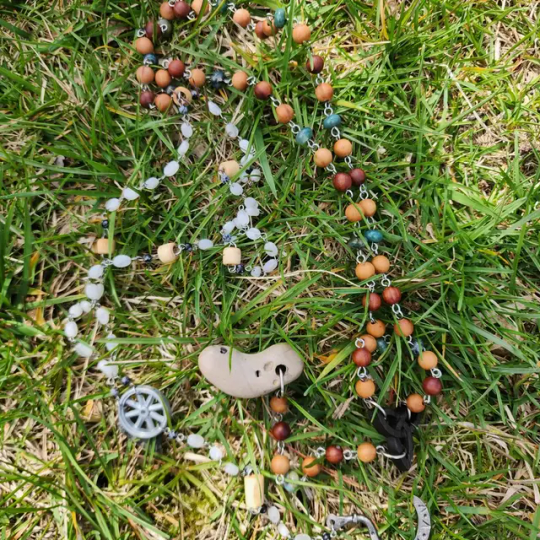
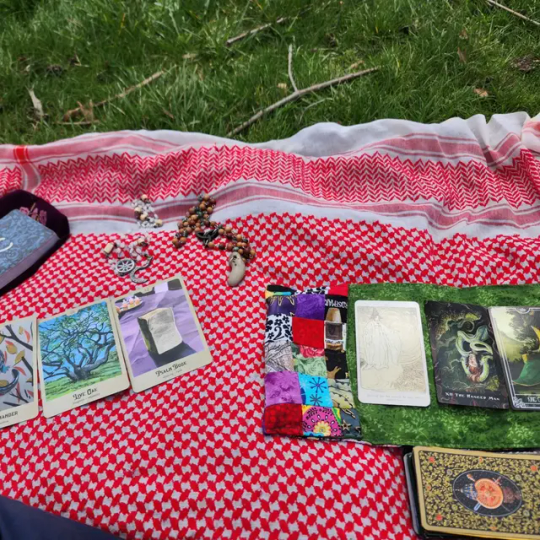
Spent the eclipse drawing cards and spending time with my deities. The new Winter Mother prayer beads from @lailoken go beautifully with the custom Celtic Faith beads I had commissioned from Lucien about a year and a half ago!
#folk magic#eclipse#solar eclipse#prayer beads#paganism#celtic paganism#scottish witchcraft#oracle cards#tarot deck
12 notes
·
View notes
Text
A spoken charm from the outer hebrides,
I make to thee a charm of Mary
The most perfect charm that is in the world
Against small eye, against large eye.
Against the eye of swift voracious women
Against the eye of swift rapacious women
Against the eye of swift sluttish women.
Protection against the evil eye.
Source:
Folklore Of The Scottish Highlands by Anne Ross.
3 notes
·
View notes
Text

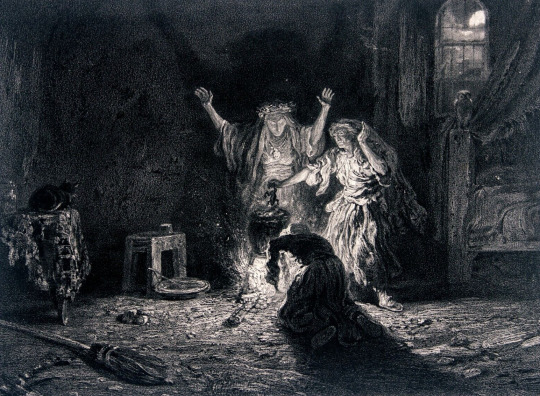
Charles-Nicolas Cochin (1715-1790) - Les Sorcières de Macbeth (The Witches of Macbeth)
#charles nicolas cochin#les sorcières de macbeth#the witches of macbeth#william shakespere#macbeth#“the scottish play”#witch#witches#witchcraft#18th century art#art#illustration#engraving
173 notes
·
View notes
Text
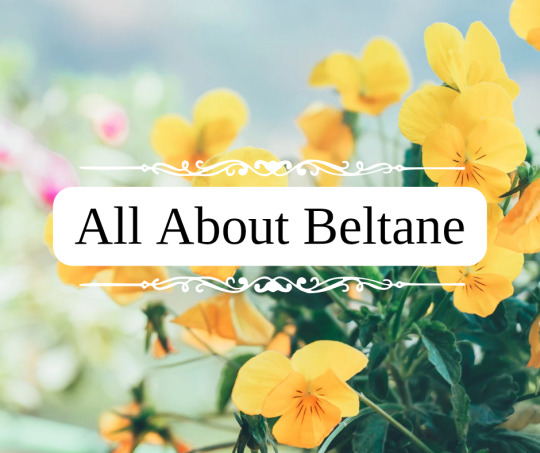
All About Beltane
Beltane, also known as Bealtaine in Irish, is a Gaelic holiday traditionally held on May 1st or the halfway point between the spring equinox and the summer solstice. It is believed to be named after the Celtic sun god Belenus. It was widely observed in Ireland, Scotland, and the Isle Of Man, and is one of the 4 major Celtic fire festivals. It is mentioned in even the earliest Irish literature and marked the beginning of summer and used as the marker to drive cattle into their summer pastures. Although public celebrations have mostly fallen out after the 20th century and many traditions have been mixed with other cultural holidays (such as the Roman holiday May Day), many Celtic Neopagans and Wiccans still celebrate, and many local traditions still continue, causing it to now get a cultural revival.
Traditionally, rituals were held to protect the livestock that moved pastures, along with crops, dairy products, and people, and to encourage growth. It was also important to appease the Aos Sí, or nature spirits/fairies, which were believed to be more active then.
According to early medieval texts in 908, druids would make two bonfires and drive cattle between them to protect them from disease. In the 18th and 19th centuries, bonfires continued to be an important part of the celebrations. Before the bonfires were lit, all hearth fires were put out, and then relit using the fire from the Beltane bonfires after the celebration.
Continuing into the 19th century, cattle were still driven over or between flames, or sometimes around the fires or made to leap over. The people themselves did as well for good luck and protection. Once the fires died down, people would dab themselves with the ashes and sprinkle them over their crops and livestock. Torches from the bonfires would also be brought home and carried around the home or boundaries, and also used to relight the hearth.
Food was also an important part of the Beltane festival, and usually included a feast of lamb, which, historically, was sacrificed. In 1769, it was written that a hot drink, called a caudle, made of eggs, butter, oatmeal, and milk was served, along with tossing a bit on the ground as an offering. A Beltane Bannock, a type of oatmeal cake, was also written to be important and had a few traditions around it.
In one tradition, the Beltane Bannock had nine knobs on it and each person would take the bannock and face the fire, proceeding to break off the knobs of bannock one at a time and tossing them behind their shoulder as an offering to the spirits for protection over their livestock and from predators (one for the cow, one for the sheep, one for the fox, etc). Afterwards, they would drink the caudle.
According to other 18th century writers, there was another Beltane Bannock tradition where the bannock would be cut into slices and one was marked with charcoal. The slices were then thrown into a bonnet and everyone would take one out while blindfolded. According to one writer, whoever pulled the marked bannock slice had to leap through the fire 3 times. According to another, the person would instead be pretend-thrown into the fire and for some time afterward people would talk about the person as if they were dead. This may have always been symbolic, or it may have been a tradition from a time where actual human sacrifice was used. This tradition was also near identical to May Day traditions that occurred in Wales and other parts of Europe, however.
Other traditions including flowers and plants were also observed, especially ones that evoked fire. Documents from the 19th century cite that yellow and white flowers, such as primrose, rowan, hawthorn, gorse, hazel, and marsh marigold was used and placed at doorways and windows. Sometimes they were strewn into garland, and other times they were made into bouquets, made into crosses, or fastened to them. They were also fastened to cows and milking/butter equipment.
Decorating a May Bush or May Bough was also a widespread tradition, and it usually consisted of a small tree or branch (typically hawthorn, rowan, holly, or sycamore) decorated with bright flowers, ribbons, candles, painted shells or egg shells from Easter, and more. In some traditions they also decorated it with gold and silver May Balls, which were hurling balls, that were then either given out to children or gifted to winners of a hurling match. It was also known as the only acceptable time to cut a thorn tree, as they were associated with fairies and may have also been a relic of worshipping tree spirits. It would either be decorated where it grew, or branches hung over windows, doors, roofs, and barns either inside or outside. Traditionally, it was the responsibility of the eldest of the house to decorate it.
The tree was usually left up until May 31st, but in some traditions it would be burned in the festival bonfire after singing and dancing around it. In Dublin and Belfast, May Bushes were brought into town and decorated by the whole neighborhood, with each neighborhood competing for the most beautiful bush. These competitions could also lead to neighborhoods attempting to steal others May Bushes, which eventually led to the May Bush being outlawed in Victorian times.
Appeasing the fairies was also a big part in Beltane celebrations, with many traditions revolving around offerings to the fairies and also warding them off, as there were many fears around them stealing dairy. One protection tradition was to leave 3 black coals under the butter churn. Another was to hang May Boughs on the milk pails. And yet another was to hang cattle tails in the barns. Flowers were also used to decorate the cattle's horns for good luck.
Farmers would also lead a procession around the boundaries of the farm and would "carry with them seeds of grain, implements of husbandry, the first well water, and the herb vervain (or rowan)", stopping at the four cardinal points of direction starting at the east, and performing rituals towards each direction at each stop. These processions were said to bring protection of their farm produce and encourage fertility. Some people also made the sign of the cross using milk on the backside of cattle for good luck.
As for fairy offerings, one tradition was to pour milk or leave food at places associated with the fairies such as "fairy trees". In Ireland, cattle were brought to "fairy forts" where a small amount of their blood was poured into the earth with prayers of the herd's safety. Sometimes, the blood would be left to dry and then be burnt.
Visiting holy wells was also a popular way to celebrate Beltane. Visitors would walk sunwise, moving from east to west, around the well while praying for health. They would then leave offerings of coins or cloth. The first water drawn from the well on Beltane was thought to be especially potent, and would bring good luck to the person who drew it.
Morning dew on Beltane was also thought to bring goodluck and health, and maidens would wash their face with it or roll in it at dawn or before sunrise on Beltane. It was also collected in a jar, left in sunlight, and then filtered. The dew was said to increase sexual attractiveness, maintain youthfulness, protect from sun damage, and ensure skin health during the ensuing year.
Modern day celebrations may vary from these more traditional festival activities, but many choose to incorporate or take inspiration from the traditions at least. Popular traditions still revolve around bonfires, feasts, decorating a May Bush, and focusing on protection and growth.
Beltane Associations
Colors - yellow, white, red, green
Food - lamb, milk and dairy, beef, bannocks, caudle, cakes
Animals - cattle, sheep, other herd animals
Items - primrose, rowan, hawthorn, gorse, hazel, marsh marigold, holly, sycamore, yellow and white flowers, flower garland, greenery, morning dew, dairy products
Crystals - citrine, fire agate, fire opal, carnelian, red and yellow jasper
Other - protection, fertility, good luck, fire, smoke, ash, sun, bonfires, farming
Ways To Celebrate
light a bonfire
jump over or dance around a bonfire
decorate a May Bush or May Bough
craft and hang flower garland
bake Beltane Bannocks
collect morning dew
create some caudle
ward and protect your home or property
leave offerings for the fairies
focus on protection, growth, and luck magic
enjoy time in the sun
have a feast
create a bouquet out of yellow and white flowers
visit a farm or petting zoo
#beltane#beltaine#bealtaine#celtic#gaelic#irish#scottish#pagan#witch#witchy#wicca#may day#magick#magic#magickal#grimoire#tradition#celebrate#bonfire#fire festival#witchcraft#spiritual#witchblr#witch community#paganism#pagan witch#celtic paganism#paganblr#about#dairy
101 notes
·
View notes
Text

Why are my friends so fucking FUNNY
#supernatural#my friends are so funny#rowena macleod#ruth connell#scottish#witchcraft#funny#text#crowley#dean winchester#sam winchester#spn
28 notes
·
View notes
Text

looks like that kid knows about paranormal activity :0
#art#my art#ttte duck#duck the great western engine#ttte donald#donald the scottish twin#donald x duck#thomas the tank engine#thomas and friends human au#sodor uk#ttte#my comic#horror comic#halloween#witches#witchcraft#the devil#satan
37 notes
·
View notes
Text

By Rowan Berry and Red Thread,
I put all Evil to its speed...
128 notes
·
View notes
Text
Information sheet + student ID for
⭒๋࣭𝑮𝒊𝒅𝒆𝒐𝒏 𝑺𝒕𝒓𝒊𝒙 𓆙

Template by @kiwiplaetzchen

Template by @acslytherpuff
#we put a lot of research into this#the scientific name for a wood owl is just “strix”#his mum is scottish and his dad was british#Gideon Strix#hogwarts legacy mc#hogwarts legacy#hogwarts oc#hogwarts school of witchcraft and wizardry#slytherin#strix#hogwarts legacy screenshots#oc#character info
20 notes
·
View notes
Text
Ancient Celtic religion (Irish, Scottish, Welsh, etc.) has been and is continuing to be culturally appropriated to absolute filth, but idk if y'all are ready to have that conversation yet
#y'all can thank white supremacists for that#even the term ''celtic'' now has racist connotations#celtic#irish#scottish#welsh#manx#cultural appropriation#religion#pre-christian religion#ancient religion#witchcraft#folk magic#folk practice#pagan#magic#witchblr#witch#polytheism
21 notes
·
View notes
Text
Dear Diary…
On Saturday I went to the grocery store to procure some tasties for a party with friends. As I pulled out of my parking space, I noticed a wind spirit swirling and playing with the leaves on the pavement.
I’ve reflected on that for three days, now. Not intensely, but it popped into mind periodically throughout my days. I wondered how it would be to feel as free as the wind, with no real responsibility but to blow some leaves across the ground, rustle the trees, and usher in a new season of crisp, chilled air.
I’ve always been particularly fond of earth spirits. They’re very grounding and calm, they can be stoic yet tender. I work with plants and herbs often in kitchen magick, herbal remedies, saining, etc, and have rarely felt the need to connect with the spirits of other elements. This is my mistake.
After witnessing the playing wind spirit, I’ve been more aware of the energies and personalities of other nature and elemental spirits around me.
Last night, for example, I was watching a film with a scented candle lit to help me relax after a long day. The flame flickered wildly, despite there being no draft to speak of. When my eyes wandered over to it, the dancing light stilled, and waved ever so slightly at the tip. Then, when I returned to watching the film, it wildly flickered again until it regained my attention. I watched it, and felt the sense that it was just a young thing wanting to be noticed and appreciated. Remembering that this candle was newly opened, I had no doubt that this little flame was something like a child.
The beauty of animism and spirit work is the realization that we are indeed connected to all things, living and non living (or at least non living by perception). Our existence as humans is preoccupied by essentially meaningless man-made design and obligatory schedule, to the point where we’ve become dissociated from this idea and consequently the natural world. Even on this journey of mine, I’m sucked into the hubbub of societal life. But it’s moments like these when I’m reminded of the truth: there is more to our world than what it seems, and there is more to explore and connect with than what we realize.
#celtic#folk witchcraft#witch community#witchblr#witchcraft#witches#green witch#witch#witch aesthetic#witchcore#ancient celts#celtic folklore#irish folk magic#irish witchcraft#scottish folk magic#Scottish witchcraft#cunning folk#cunning woman#spirits#spirituality#spirit work#nature#nature spirits#animism#witch blog#traditional witchcraft#folk witch#witches of tumblr
30 notes
·
View notes
Text
Welcome!!
My name is Soph and this is my blog!
I’ve never actually posted on Tumblr, so bear with me:))
I’m going to use this as a digital tool to give offerings and devotions to Lady Brigid🕯️
🐌🔮🌿🐈⬛🌙
20y
she/her
celtic pagan witch🍀🧹🦢



#aboutmyself#aboutme#witchblr#beginner witch#witchcraft#witchcore#witch community#witch aesthetic#witches#paganism#pagan witch#pagan#paganblr#pagans of tumblr#celtic paganism#celtic mythology#celtic witch#celtic polytheism#brigid#brigid devotee#brigid deity#hedge witch#protection magic#scottish#irish witchcraft#celtic#brigid goddess#devotional#devotional blog#deity work
26 notes
·
View notes
Text
Angus Óg/Aengus
A guide
I've decided to write a little profile and deity guide on some of my Gods for anyone who might want more information or want to work with/worship them. So I've decided to start with Aengus :)
Disclaimer: Aengus is found in both Irish and Scottish paganism as both religions overlap greatly (Scottish Paganism originated from the Irish). I'm Scottish, so this will mostly be tailored towards Scottish Paganism and my understanding of Angus Óg as a Scottish pagan.
Not much is known about Celtic Gods as a whole in the modern day and things are very muddled, so there will be different understandings/interpretations of the Gods.
This is from my own experience working with him as well as research.

Angus Óg is the Irish & Scottish Celtic God associated with love, youth, beauty, poetry, and life.
In Scottish Folklore he is the son of Beira. Bride is often depicted as his lover.
Other names: Aengus, Aonghas, Óengus
Symbols/Associations: Harps, white birds, roses, rose quartz, rubies, a white horse
Planet Association: Venus
Season: Summer
Colours: Green, red, pink, gold
Offerings: Wine, roses (and other flowers), apples, feathers, honey, rose quartz
Devotional Acts:
Writing poetry or songs (especially about love)
Spending time with loved ones
Acts of kindness
Making drawings/paintings/artwork of him or related to him
Planting flowers/gardening
Having a self care day/night
Taking a meditative bath
Listening to music, especially love songs
Honouring Bride and Spring
My Experience: From my experience, Angus Óg is very open. He is quite playful yet patient. He seems happy when I create art for him and is always really kind and encouraging about it. He feels full of energy and wisdom and likes hearing about all my little crushes and speaking about relationships. He is intelligent and well-spoken and likes you to take care of yourself and your loved ones. His presence is gentle and soft, yet radiant.
I've found he is a really good deity for beginners and would recommend reaching out to him if you're interested in Celtic Paganism!
#celtic paganism#paganism#pagan#celtic#scottish#scottish paganism#pagan witch#eclectic pagan#folk witchcraft#folk witch#deities#angus óg#aengus#aonghas#óengus#deity worship#deity work#devotional acts#worship#bride#brigid#beira
21 notes
·
View notes
Text
Picked up this trinket box with a bell hanging from the lid at one of my local charity shops today!
I find it so much more worthwhile finding things for it second hand than just buying it brand new all the time. Even if I don't worship any particular deity - my practice is much more nature/spirit focused - I feel an appreciation for it. Maybe because it cyclical?
Anyways - I'm hoping to polish him up to place on my small altar later ❤️
#witchblr#witchcraft#pagan#pagan witch#celtic wicca#scottish pagan#celtic#kitchen witch#scottish witch#own post#celtic witchcraft#witch#wiccan#witch bells#altar#celtic altar#witch altar#kitchen magic#kitchen witchcraft#green witch#witch community#secondhand
14 notes
·
View notes
Text
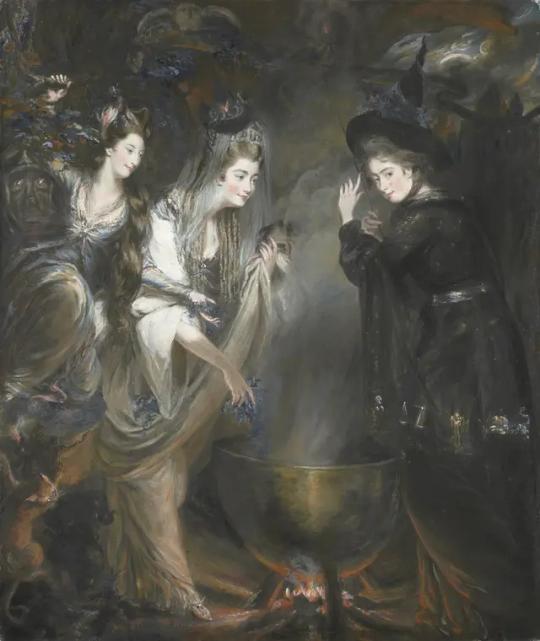
Daniel Gardner (c.1750-1805) - The Three Witches from Macbeth, 1775
portraits of Elizabeth Lamb, Viscountess Melbourne; Georgiana, Duchess of Devonshire; Anne Seymour Damer
#daniel gardner#the three witches from macbeth#william shakespere#macbeth#“the scottish play”#witch#witches#witchcraft#portraits#18th century art#art#gothic romanticism#painting
252 notes
·
View notes
Text

Celebrate International Faerie Day in the Enchanting Realm of the Isle of Skye
Nestled within the rolling hills of Scotland lies the mystical faerie realm of the Isle of Skye. Here, lush green hills, shaped by ancient grey stones, cradle the enchanting Faerie Pools scattered throughout the valley. This moss-covered landscape, imbued with sacred energy, belongs to the fae.
Standing atop these hills, you can witness the ocean gently kissing the shore while the mossy stone mountains embrace the ruins of ancient castles. In this magical setting, the fae invite you to immerse yourself in the wonder of their lands.
This Chrysanthemum stone features a naturally occurring shadow resembling a faerie on its inky surface. 🌑 Known for its mystical properties, the Chrysanthemum stone helps you manifest your dreams and deepen your connection to your intuition. Placing this stone by your bed can foster a connection with the fae in your dreams. Representing the balance of light and darkness, this stone harmonizes with both the full and new moon, making it a powerful tool for spiritual growth and transformation.
#crystals#pagan#wicca#druid#witch#goddess#magick#witchy#faeries#crystal#chrysanthemum#crystal collection#witchcraft#isle of skye#scotland#scottish mythology#united kingdom#fairy#fairy energy#international faerie day#international fairy day
18 notes
·
View notes